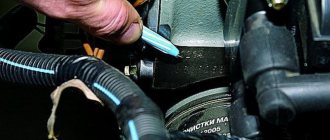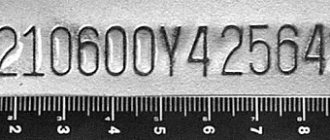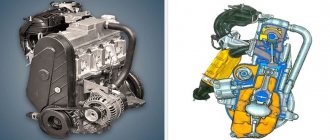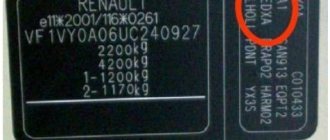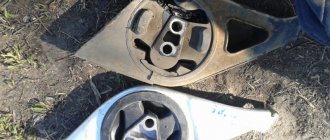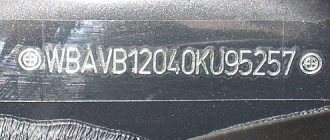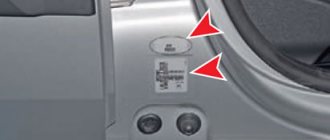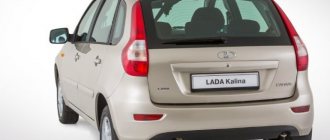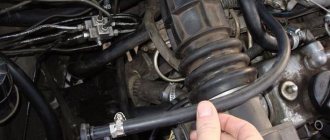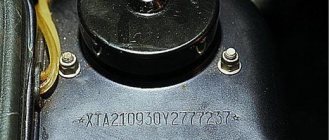The Lada Kalina family of cars includes the VAZ-1118 with a four-door sedan body and the VAZ-1119 with a five-door hatchback body. The vehicles belong to an especially small class (class B according to the international classification) and are designed for operation at ambient temperatures from -40 to +45 °C on public roads with hard surfaces. Lada Kalina cars are equipped with an 8-valve engine of the VAZ-21114-50 model with a displacement of 1.6 liters (factory vehicle modification indices - VAZ-11183 and VAZ-11193) and a 16-valve engine of the VAZ-11194 model with a displacement of 1.4 liters (factory car modification indices - VAZ-11184 and VAZ-11194). Both engines are located across the engine compartment and are equipped with a distributed fuel injection system and a catalytic exhaust gas converter, structurally made in a single block with the exhaust manifold.
The body is monocoque, all-metal, of welded construction with hinged side doors, front fenders, hood and trunk lid (tailgate). The transmission is made according to a front-wheel drive system with drive wheels of different lengths. The front suspension is independent, spring, with anti-roll bar, with hydraulic shock absorber struts. The rear suspension is dependent, lever-spring, with hydraulic shock absorbers. The front wheel brakes are disc brakes with a floating caliper, the rear wheels are drum brakes. The steering is safety-resistant, with a rack-and-pinion steering mechanism and an electric booster. Lada Kalina cars are equipped with a remote control system for locking or unlocking side door locks (in a variant, also locking the trunk lid or tailgate lock) with simultaneous activation or deactivation of the vehicle security mode. In addition, provision is made for remote activation of alarm systems in case of violations of vehicle security zones and blocking of all side rails (in the optional version - the rear) by pressing a button from inside the car. The overall dimensions of the VAZ-2118 car are shown in Fig. 1.1, VAZ-2119 car in Fig. 1.2, technical characteristics in table 1.1. Elements of the engine compartment of the Lada Kalina car are shown in Fig. 1.3 and 1.5. The location of the main components and assemblies of the car is shown in Fig. 1.6)
Rice. 1.1 Overall dimensions of the VAZ-2118 car
Passport details of Lada Kalina
In the engine compartment there are: A - body identification number; B - identification mark; B - engine model and number. Identification number (For the vehicle, engine model, name of the manufacturer, year of manufacture and certification information are given in the identification plate (Fig. 1.4).
The vehicle identification number is stamped on the right shock absorber support in the engine compartment on the strut.
Vehicle registration details
Vehicle registration details in the engine compartment:
1 - Vehicle identification number (VIN)
2 - Vehicle data plate
The Vehicle Identification Number (VIN) is stamped on the right mudguard cup, next to the shock absorber strut upper mount. The Vehicle Identification Number (VIN) is deciphered as follows: XTA
— according to international standards, manufacturer’s code; 111930 — car model; 7 - model year of manufacture (7 - 2007); 0014223—body number.
The vehicle identification number is duplicated on the wheel arch of the rear right wheel. If necessary, check it by folding the right side of the rear seat backrest.
. and peel back the cut part of the upholstery (the vehicle identification number is shown by the arrow)
The engine model and number are stamped on the cylinder block area located above the clutch housing (you can see the number by removing the air filter housing or using a small mirror).
Hi all! On November 3rd I went to register the car. Everything happens in the city of Naberezhnye Chelny. I heard that there was something wrong going on at the traffic police, and there were long queues. I filled out an application at the office to change the owner of the car. (240 rubles, including all copies). I have been printing out and filling out the purchase and sale agreement myself for several years now. Then I drove to the reconciliation site. One inspector goes through all the cars. I found the second VIN code. It is located under the back of the rear right seat (but they did not look at it). Based on the fuss of many owners, I realized that the engine number is also checked. For convenience, I removed the air filter box. I didn't see anything positive. Something was visible, I thought it would give me a ride.
He came to me five times and applied rust neutralizer.
The major approached. I told my assistant to remove all the paint on the last six numbers. The cup was painted, only the first layer was cleaned.
They gave me a certificate.
In the spring of 2016, they began checking engines again. So now, when buying a car, you need to be more vigilant.
Next stage! We need to submit documents. To do this, you need to write an application at the State Services and take an electronic queue there. I did this on November 7th, the next free day. The department accepts it regardless of what day you are signed up for, you just need to get in line.
On the morning of the 4th, a holiday, I went to submit my documents. Got in line. Short day. And the inspectors decided on this day to accept only those who registered for this day. So he left.
I arrived on Monday and calmly handed over the documents. There were 3 people before me. We found fines. A year and a half ago I sold nine. Still not registered. I had PrEP with me, which resolved this issue. An hour later I picked up the documents.
On the day of reconciliation, I made a duplicate of the numbers in advance. The old ones were worn out for 8 years. And here they don’t stand on ceremony with the old ones, “Replace the numbers!” and that's all. It cost 750 rubles.
Location of the engine number on the VAZ-2112
It happens that unknowing car enthusiasts are able to spend more than one hour under the hood of a car looking for the required identification number. The thing is that during operation, some of them can become covered with a thick layer of dirt, which makes them simply unsuitable for visual perception without prior preparation.
Layout of identification numbers under the hood
The photo below shows schematically where all the identification numbers are located under the hood.
The numbers indicate the location of the ID numbers.
- The car number marking ( VIN code ) is located here.
- Under the number two, all the installation passport data.
- The engine number is located under the thermostat housing, on the cylinder block . For convenience, you will have to move the air filter housing to the side.
Engine number here!
In order to check the engine number, you need to have a wire brush and WD-40 on hand in advance to make it easier to read dirty or corroded symbols.
VIN code
The vehicle identification number, in addition to being on the support cup under the hood, is also stamped in the niche for the spare wheel in the trunk . As a rule, they are always readable after a little cleaning with a rag.
Engine number on 16 valve
They changed the thermostat and checked the engine number!
The same cannot be said about the engine number, since its location is subject to constant exposure to road salt, reagents and high moisture. To make it easier to clean and read this number, you need to remove the air filter housing with the corrugation and you will see 2 rows of numbers on the block.
About Lada Kalina
ATTENTION! A completely simple way to reduce fuel consumption has been found! Don't believe me? An auto mechanic with 15 years of experience also didn’t believe it until he tried it. And now he saves 35,000 rubles a year on gasoline! Read more"
Having replaced the outdated “classics”, Lada Kalina embodied the expectations of many lovers of VAZ models. It continued to be produced as a budget car option that the average Russian family could afford to buy.
Today, cars of the Kalina family series are presented in 3 body variations: a station wagon called VAZ 21117, a VAZ 21118 sedan and a VAZ 21119 hatchback.
All these car modifications are characterized by a large interior and compact shape. New-fangled design, body strength and modern technologies - all of these modifications of the Kalina family combine to the fullest.
Among the main advantages of the Kalina body are a wide variety of colors, rigidity and much more. But among the shortcomings, many note the insufficient level of sound insulation.
The world's first Kalina was released in 2004. A lot of time has passed since then. Owners of used Kalinas are often interested in the features of repairing individual body elements.
Approximate cost of repair work on the Kalina body at a service station
Here are the prices offered today at various repair services.
| Replacement, removal and installation of body parts | Price, rubles |
| Hood replacement (removal/installation) | 1800 |
| Front fenders (removal/installation) | 1600 |
| Front doors (removal/installation) | 2200 |
| Rear doors (removal/installation) | 2000 |
| Bumpers (removal/installation) | 1800 |
| Sedan trunk lid (removal/installation) | 1900 |
| Replacement of load-bearing body elements | Price, rubles |
| Roof panel | 9000 |
| Wing | 14 000 |
| Spar | 11 000 |
| Door threshold | 9000 |
| Door pillar | 8000 |
| Slip works | Price, rubles |
| Installing the car on a slipway to remove reference points to check the geometry of the body | 4000 |
In principle, the prices are not that low. It would be better to learn how to replace (which is much easier) or repair it yourself. We are not talking about competently taking body dimensions to compare geometry. This, of course, should be done only with high-quality equipment, which is almost impossible to provide in a garage workshop.
On the other hand, useful information about the geometric dimensions of Kalina’s bodies will be presented below, which will make it possible to remove them yourself using a regular tape measure.
Watch a video about problem areas of the Lada Kalina body
How to read information
To read the marker, where the engine number is written on the Lada Kalina, you need to get to it. For this purpose, remove the housing of the air filter element and move the wires to the side. Government officials use a mirror that helps them check information without disassembling it, provided it is not dirty.
Engine number Lada Kalina:
The identifier on the glass contains information that is interpreted:
Production year designations:
| Of the year | Designation |
| 2005-2009 | 5.6–9(respectively) |
| 2010 | L |
| 2011 | IN |
| 2012 | WITH |
| 2013 | D |
| 2014 | B |
| 2015 | F |
| 2016 | G |
| 2017 | H |
Number on the shock absorber strut:
Remember that the markings on the shock absorber strut and arch are the same. Knowing where the engine number is located on the Lada Kalina is the responsibility of every user. Do not forget that a lot of information is contained on the plate attached to the radiator frame.
The information provided can be deciphered as follows:
The symbols used when ordering parts are stamped in the vertical column; the design option and the kit used are indicated below.
Geometric dimensions of the openings of the VAZ 2118 sedan (Lada Kalina)
| Distances | Dimensions, mm |
| Distance along the long diagonal of the front door opening | 1370 |
| Front door opening short diagonal distance | 1014 |
| Front door vertical center distance | 960 |
| Diagonal distance of the front window opening | 1145 |
| Central horizontal distance of the front window opening | 1130 |
| Distance along the central vertical of the front window opening | 870 |
| Rear window opening diagonal distance | 1123 |
| Center horizontal distance of rear window opening | 1112 |
| Distance along the central vertical of the rear window opening | 600 |
| Luggage compartment opening diagonal distance | 1010 |
| Horizontal distance of luggage compartment opening | 970 |
| Distance along the central vertical of the luggage compartment opening | 515 |
Measurements of geometric dimensions should be carried out correctly. So, if a car has a roof leak, you need to measure the diagonals of the roof; if there are problems with the openings, then the openings accordingly.
The causes of geometry violations can be not only accidents or serious accidents. If you often drive on uneven roads, encountering various obstacles, the position of certain body elements may change. In principle, suspension is provided for such cases, but over time it weakens, and its vibrations, like it or not, are transmitted to the body.
In most cases, the geometry is tested before purchasing a used Kalina. An event carried out competently provides information about whether the previous owner’s car has been in an accident or not, what the condition of the body is, etc. In addition, diagnostics of this kind are recommended to be carried out regularly by car owners for preventative purposes.
Many experts recommend that owners examine the body geometry even after any repairs carried out at a service station. It happens that in the process of these repair manipulations the qualifications of service workers turn out to be insufficient. They only restore the body and its parts externally, but in reality the distances turn out to be shifted.
Obvious features of body damage are visible even without measurements. For example, if Kalina’s doors begin to close or open poorly, it is recommended to do a full geometry check.
Another symptom of body displacement is the unstable behavior of the car on the road at high driving speeds. It moves around, it vibrates, etc.
Geometry
Body geometry of Lada 1118
The most accurate way to measure and take the geometric dimensions of the Lada Kalina body in a garage is to use the method of measuring the same distances on both sides of the body or a specific part. The measurement should be carried out between certain points, usually called control points, and then the readings should be checked against the factory ones.
In a station wagon
Today, many experts see the station wagon as the best creation of the Kalina family. Indeed, although its exterior is not distinguished by noticeable and catchy solutions, in order to appeal to a certain caste of consumers, it is an ideal vehicle of the classic type.
Initially, the designers were given the goal of inventing and constructing a car that would meet the needs of the masses. It was supposed to become a universal vehicle for every day. Both men and women had to like the car.
Regarding body production technology:
- 33 new materials were used in assembling the station wagon body to ensure European quality standards and compliance with safety standards. This includes not only metal parts, but also plastics, paints and much more;
- The corrosion resistance parameter has been increased several times, thanks to competent and complete galvanizing of parts exposed to greater exposure to aggressive environments
- The design of the body and interior parts was obtained entirely using computer geometric modeling. Thanks to this, it was possible to increase the rigidity and safety coefficient several times. This also affected the quality of manufacturing and mating of the front body parts;
- Welding work is carried out exclusively by robotics. Today, according to the plant administration, about 360 robots are used.
Among other advantages of the body, we can highlight the large spaciousness of the interior and luggage compartment. This, in turn, was achieved due to a successful layout solution aimed solely at increasing the volume of internal space. In addition, the car was designed with a high seating position, which provided good visibility.
The procedure for deciphering the VIN code by numbers
The VIN code never contains the Latin alphabetic characters “I”, “O” and “Q” due to some similarity with the numbers “1” and “0”.
Decoding the VIN code yourself is a rather labor-intensive process.
The VIN number shown in the picture below will be used as an example of decoding.
The positions of the VIN code must be deciphered strictly in order.
1 - country
The first position in the VIN code always indicates the country of manufacture of the car. In other cases, several characters are used to identify the country.
There are a lot of codes designating regions, but the most common are:
- 1, 4 and 5 - United States of America;
- 2 - Canada;
- 3 - Mexico;
- J - Japan;
- K – Korea;
- S – Great Britain;
- W – Germany;
- Z – Italy;
- Y – Sweden;
- X – Russia, the Netherlands and Uzbekistan;
- 9 – Brazil.
In the picture, the first character is X, the country of origin is Russia, the Netherlands or Uzbekistan.
2 and 3 - vehicle manufacturer
The next two positions show the vehicle manufacturer.
The codes of many international companies consist of several characters. Like country identification, plant identification may require all three characters.
The picture shows two 7L symbols; you have to search using all three symbols X7L—Renault AvtoFramos (Russia).
The Renault concern has many factories: MEE - India, VF1, VF2, VF6 (trucks) and others. For example, AVTOVAZ has the code XTA.
To designate a manufacturer producing less than five hundred vehicles per year, the number nine is indicated in the third position.
From 4 to 8 digits - characteristics
The fourth to eighth characters describe the various characteristics of the vehicle and its type:
- the lineup;
- body type;
- drive unit;
- engine;
- transmission;
- steering wheel locations and others.
Each car manufacturer has its own set of characteristics, its own unique designations.
We will consider according to the classification for Renault assembled in Russia.
- C or 3 - three-door hatchback;
- B or 5 - five-door hatchback;
- S or 6 - five-door combi;
- K or A - three-door station wagon;
- E or 7 - two-door convertible/truck with sides;
- D or 8 – two-door coupe/convertible;
- J or N - five-door station wagon/minivan;
- U or H - pickup;
- M or 2 - two-door sedan;
- L or 4 - four-door sedan.
In our case, the first letter L denotes the vehicle body type—sedan.
A number of models presented in Russia are encrypted in the fifth position:
- A - Megan I;
- B – Clio II;
- C – Kangoo;
- D – Master;
- G – Laguna II;
- L – Traffic;
- M – Megan II;
- S – Logan;
- Y – Koleos.
The fifth position in our case indicates the S – Logan model range.
The sixth and seventh positions for this example indicate the engine code - RB, in the example under consideration the KJ7 engine - engine capacity 1.4 liters, eight-valve.
In the eighth position is the territorial location of the plant that produced the vehicle.
Cars that came off the Avtoframos assembly line have the same code as Turkish vehicles - 2.
9th number - check digit
Most automobile concerns use a symbol in the ninth position to check the check digit, which is calculated: all numbers and Latin letters (each letter is assigned its own digital value) in each position of the VIN code are multiplied by the position number code (multiplier), with the exception of the check digit, and the sum of the products all positions are divided by eleven.
If the remainder in the received response is similar to the control value, the VIN code is real.
Digital values of VIN letters: A=1, B=2, C=3, D=4, E=5, F=6, G=7, H=8, J=1, K=2, L=3, M =4, N=5, O=6, P=7, R=9, S=2, T=3, U=4, V=5, W=6, X=7, Y=8, Z=9 .
Position code (multiplier): 1st=8, 2nd=7, 3rd=6, 4th=5, 5th=4, 6th=3, 7th=2, 8- 1st=10, 9th=0 (check digit), 10th=9, 11th=8, 12th=7, 13th=6, 14th=5, 15th=4, 16th=3, 17th=2.
10 letter (number) - year of manufacture of the car
The symbol in the tenth position indicates the year of manufacture of the vehicle.
Not every vehicle manufacturer follows this regulation.
| 1971 | 1 | 1986 | G | 2001 | 1 |
| 1972 | 2 | 1987 | H | 2002 | 2 |
| 1973 | 3 | 1988 | J | 2003 | 3 |
| 1974 | 4 | 1989 | K | 2004 | 4 |
| 1975 | 5 | 1990 | L | 2005 | 5 |
| 1976 | 6 | 1991 | M | 2006 | 6 |
| 1977 | 7 | 1992 | N | 2007 | 7 |
| 1978 | 8 | 1993 | P | 2008 | 8 |
| 1979 | 9 | 1994 | R | 2009 | 9 |
| 1980 | A | 1995 | S | 2010 | A |
| 1981 | B | 1996 | T | 2011 | B |
| 1982 | C | 1997 | V | 2012 | C |
| 1983 | D | 1998 | W | 2013 | D |
| 1984 | E | 1999 | X | 2014 | E |
| 1985 | F | 2000 | Y |
Body and external accessories
Before buying a car, always check for scratches on the paintwork. It would be better to add the following to this action:
- It is necessary to pay attention to the size of the gaps, as well as to ensure that the transitions between body parts are uniform;
- The safety of the paintwork is checked on the surface of the body, on all ends of the doors, on all thresholds;
- You need to check the presence of plastic fender liners in the front arches;
- The type of rubber on each of the four tires should not be different;
- The plug located under the gas tank cap must be equipped with a retaining cord.
Even before starting the engine, try unscrewing the tank cap and then install it in place.
The plastic stopper additionally holds the cord
As you continue to inspect the vehicle, you can pay attention to the following elements:
- Headlights installed at the front should not have chips or scratches;
- The same applies to the rear signal lights;
- There should also be no scratches on the glass or side mirrors.
Finally, try folding both mirrors located on the outside of the body. If it is determined that everything is in order with the mirrors, you can proceed to inspect the interior.
In the rear doors of the Kalina-2/Granta family of vehicles, a mechanism is installed that allows you to block the door from being unlocked from the inside. On the front side there is a lever that rotates 45 degrees. On the left door the lever is turned to the left, on the right door - clockwise. This is how the serviceability of the locking mechanism is checked.
Engine tuning
To improve the performance of the 11183 engine, several types of tuning can be used:
Practice shows that chip tuning for 8-valve internal combustion engines is not effective, and turbocharging leads to increased wear of parts, so these methods are rarely used.
Thus, the 11183 motor has a serious advantage - it does not bend the valves with pistons when the timing belt drive breaks. However, there are a number of shortcomings that were corrected only in later versions of engines from the manufacturer AvtoVAZ.
Interior and engine compartment space
All doors, hood and trunk lids should open without jerking. The hood must be pressed against the body in the closed position. The spare wheel, wheel wrench and jack are always kept in the luggage compartment. Having verified this, proceed to inspect the engine compartment:
- Check the level of antifreeze, as well as brake fluid (the body of the tanks is made translucent);
- Check the level of engine oil and gearbox oil (use a dipstick);
- You can pay attention to the release date of the battery. The numbers will be printed on top of the negative terminal or on the battery body.
Note that now some factories do not explicitly print the battery production date. Instead, special code is used.
The numbers 309 mean the following: third month, 2009
Of course, it would be advisable to check the engine and body number with the values indicated on the PTS coupon. In Kalina-2, all the numbers need to be looked for under the hood:
The three most important signs
The following elements are indicated in the figure:
- Engraving with body number;
- Engine number plate;
- Pivot table with general data.
Inside the car, they check whether the main blocks and components can be adjusted:
- Front seats;
- Front seat head restraints;
- The rear seats should fold easily;
- The steering column should move up and down and lock into place;
- Air duct guides should be easy to adjust;
- The mirrors are adjusted with special levers.
It is necessary to check whether each of the seat belts is securely fixed in the connector. You can also try shifting the gearshift knob without starting the engine.
The serviceability of seat belts is checked as follows: the belt is pulled sharply, after which the tightening mechanism is activated.
Lada Kalina repair and operation manual
The Lada Kalina family of cars includes the VAZ-1118 with a four-door sedan body and the VAZ-1119 with a five-door hatchback body. The vehicles belong to an especially small class (class B according to the international classification) and are designed for operation at ambient temperatures from -40 to +45 °C on public roads with hard surfaces. Lada Kalina cars are equipped with an 8-valve engine of the VAZ-21114-50 model with a displacement of 1.6 liters (factory vehicle modification indices - VAZ-11183 and VAZ-11193) and a 16-valve engine of the VAZ-11194 model with a displacement of 1.4 liters (factory vehicle modification indices – VAZ-11184 and VAZ-11194). Both engines are located across the engine compartment and are equipped with a distributed fuel injection system and a catalytic exhaust gas converter, structurally made in a single block with the exhaust manifold.
The body is monocoque, all-metal, of welded construction with hinged side doors, front fenders, hood and trunk lid (tailgate). The transmission is made according to a front-wheel drive system with drive wheels of different lengths. The front suspension is independent, spring, with anti-roll bar, with hydraulic shock absorber struts. The rear suspension is dependent, lever-spring, with hydraulic shock absorbers. The front wheel brakes are disc brakes with a floating caliper, the rear wheels are drum brakes. The steering is safety-resistant, with a rack-and-pinion steering mechanism and an electric booster. Lada Kalina cars are equipped with a remote control system for locking or unlocking side door locks (in a variant, also locking the trunk lid or tailgate lock) with simultaneous activation or deactivation of the vehicle security mode. In addition, provision is made for remote activation of the alarm system in case of violations of vehicle security zones and blocking of all side rails (in the optional version - the rear) by pressing a button from inside the car. The overall dimensions of the VAZ-2118 car are shown in Fig. 1.1, VAZ-2119 car in Fig. 1.2, technical characteristics in table 1.1. Elements of the engine compartment of the Lada Kalina car are shown in Fig. 1.3 and 1.5. The location of the main components and assemblies of the car is shown in Fig. 1.6)
Rice. 1.1 Overall dimensions of the VAZ-2118 car
Location on the engine
Many car enthusiasts ask the question - where is the engine number on the Priora? It’s easy to find engine numbers for 8 and 16 valve Lada Priora. They are located on the cylinder block, above the clutch housing. To detect it and look, you need a mirror or dismantling the power unit.
Thus, state traffic inspectorate employees, when removing and registering a vehicle, check this identifier with others to make sure that there was no unauthorized substitution of the engine.

